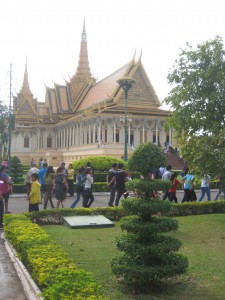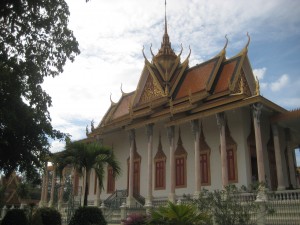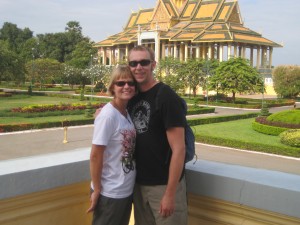Our final stop in Cambodia was the capital, Phnom Penh. This is a city that has basically been to hell and back since the 1970’s, when Pol Pot and the Khmer Rouge came to power after winning Cambodia’s civil war. Most of the things we saw here focused on the horrific attempt at genocide that went on between 1975 and 1979; as I describe some of the things that happened not so long ago in the places that we were visiting here, it will be obvious why almost no photos accompany this blog. Phnom Penh was a not as fun as our other stops in Cambodia, but I am very glad that we went there.
 The bus took all day, thanks in part to a flat tour, so our only activity for the night was finding dinner; the budget places in Phnom Penh aren’t really around too many restaurants that don’t serve “If you can identify it then it’s free†meat soup (which we actually ate for breakfast the next morning), so we couldn’t really be picky. Somehow, we ended up at a Chinese Seafood restaurant where we were the only customers, and about 15 teenage girls (there is no escape for this coach and teacher!) stood beside our table for the entire meal, taking turns filling our water glasses every time we took a sip. No one really spoke English, and we don’t speak Chinese, so we just smiled and nodded awkwardly at one another as we tried to look like we knew what we were doing with our chopsticks and rice.
 Sunday, we hit the riverside part of town; the war stuff is all sort of outside of town, so we decided to it the next day. I made a deal with the moto driver that gave us a ride today to come back tomorrow, and we would hire him to take us to the S21 prison and the killing fields outside town. Today would be the light day, and tomorrow we would do the heavy stuff.
 Our first stop was the National Museum, which had a ton of statues of Hindu and Buddhist deities and pieces of old temples. After being at Angkor Wat and seeing hundreds of Buddhist and Hindu statues in the past three months, we had sort of reached our statue statute (Oh, damn, I’m good!). There were, however, some neat black and white photos of Angkor Wat, some of which had been done during lightning storms (I would say that they were striking, but I figure you might not be recovered from the statue statute moment) and another black and white photo exhibit of classic Khmer dancers from the early 1900’s.
 The other things we wanted to see for the day were the Royal Palace and Silver Pagoda, which were the same exhibit, but most government things close for a couple of hours in the afternoon, so we sort of poked around through some shops and found a place with some of the strong, sugary iced Cambodian coffee that neither one of us can get enough of! My knees haven’t stopped doing the sewing machine thing since we left Thailand!
 The Royal Palace is a cluster of fancy temples and similar buildings that look very much like palaces and temples in Thailand–much of Thailand was under Angkor rule at one time, and the two countries have very similar histories, so we notice some overlaps. Like in Bangkok, you aren’t allowed in any of the actual palace buildings, so we visited a throne room and called it good. I was more excited about talking to the guy with a Wenatchee, Washington t-shirt that had an apple on it; his sister was a teacher there, and so he knew the area–it gave us something to discuss while we took pictures of one another in front of buildings that we paid to see but couldn’t enter.
 Of more interest was the Silver Pagoda, which has a floor made of 5,000 silver tiles; at 1kg per tile, the floor weighs a whopping 11,000 lbs! Inside the Pagoda are scores of silver Buddhas, a tiny crystal Buddha, and a larger diamond-studded Buddha that weighs 90 kg (more than me) and sports 9,584 diamonds–pretty spectacular! The forehead held the largest gem; I think it was over 30 karats–not bad for a deity willing to forsake all earthly possessions.
 Phnom Penh has some really cool training programs designed to create opportunities that will get needy kids off of the street and into careers, and we wanted to support this honorable cause. It was a win-win situation, though, because Rom Deng was a great place for us to dine that night. It is a beautiful teak building with courtyard seating elegantly lit and surrounding a pretty swimming pool. If you ever want good service, go to a place where the workers have known hunger and poverty–these young men and women were some of the most professional, friendly people we’ve met during this trip. The food was excellent, too, and this was one of the most rewarding dining experiences that we’ve had.
 Right next door to Rom Deng was the Zeppelin Café, the only bar that I had really wanted to visit in Asia. The place is a dive, but they have piles of 70’s and 80’s vinyl stacked to the ceiling, and the walls are covered in old rock posters. We were almost the only ones in there, and we played cards and had a couple of beers while we rocked out to ACDC, old school Metallica, the Stones, the Sex Pistols, and of course, Led Zeppelin. It was awesome!
 On Monday morning, we headed off to visit S21, the school which had been turned into a deadly and torturous prison by the Khmer Rouge. I am glad that we went to S21, but it is not an enjoyable place to visit by any means. Haunting is a much more apt description. As with most other tourist places in Cambodia, you are met by begging amputees who have either been maimed by land mines in the years following the Khmer Rouge’s reign (significant numbers of people are still injured by land mine explosions every year in this country because Pol Pot ordered as many areas as possible to be mined before his retreat), or by the Khmer Rouge soldiers themselves in a few cases with the older victims. We tried to give a little as often as we could while here.
 Once inside the outer walls, you are greeted by a cemetery that holds the final 14 victims tortured and killed at S21; they are buried on a spot which I imagine once served as a playground or for flirting by teens between classes. Across the yard was a rope tower that was used for PE classes once, but the Khmer Rouge–under the orders of a former math teacher who became the administrator of S21, “Duch†(as of February of this year, his appeal in court was thrown out and his sentence was actually extended from 35 years to life), it became a torture device used to hang prisoners upside down–I won’t tell you how they “revived†the prisoners who passed out. This usually went on until they confessed to whatever crime they were accused of committing, often times being a spy for the CIA or KGB, and they would then be killed.
 The classrooms in the “A Wing†have been left bare, except for the decayed cot, a bar that was used to shackle prisoners by the feet, and what appeared to be a battery, long corroded, that probably delivered countless shocks during its lifetime in S21. Each room featured horrible photos of torture victims, some deceased, and most unrecognizable after the violence that had befallen them. I guess this is a good time to mention that Pol Pot wanted to rid himself of any potential threats to his power; these included supporters of the former government, Buddhist monks, and anyone who showed signs of being more than an obedient, uneducated peasant; people could be killed or imprisoned for such telltale signs of treason as wearing glasses, speaking a foreign language, or having soft hands. The prisoners in the “A Wing†were mostly political prisoners, and their deaths were not quick; the reinforced, soundproof windows in the rooms reflect this.
 Most of the other three wings of S21 combine information about the Khmer Rouge, stories of the seven prisoners that survived, and most poignantly, photos of the thousands of prisoners that had gone through the prison–the Khmer Rouge, sort of like the Nazis, were very thorough in keeping records on the prisoners and documented a good deal of the torture as well. As I walked through the rows of photos, I inadvertently walked in front of a guy who was trying to see the photos himself; I said, “sorry,†meaning “excuse me,†and he thought that I was apologizing for what had happened in his country. He was a Cambodian man that was visiting S21 because he had heard that his brother and sister had been killed here, and he was looking for their photos. Like many young Cambodians who had been forced to serve, his brother had been a soldier who was eventually been accused of betrayal and killed. The man beside me had been 10 at the time, and many years had passed before he even learned the fate of his family.
 After leaving S21, our ride to the Killing Fields was almost silent. Over 20,000 people had been killed brutally at S21 during it’s four years of operation. The victims’ faces are images that I will not soon forget. It had been one thing to read the excellent memoir, First, They Killed My Father in the past week, but seeing these things today brought the reality of Pol Pot’s reign of terror that much more into focus. Our moto driver was pretty old today…what had he seen during his lifetime? Had he suffered? Had he served? How many family members of his left one day and never returned?
 Our second stop, the Killing Fields of Choeung Ek are actually only one of many mass burial sites in Cambodia–a good deal of which probably will never even be found because the areas are so remote or laced heavily with land mines. Many of the prisoners from S21 were transported to these fields for execution; most of them were bludgeoned by hoes, hammers, and other common hand tools because bullets were expensive, and the country was poor. In one spot stands a tree next to one of the mass tombs called “the tree of magic†that had been used to murder children by swinging their heads up against it. As you walk through the area, which had once been gorgeous orchards and is still surrounded by lovely gardens and a serene pond, we saw teeth and clothing from the tombs; they still wash up after the rains.
 What struck me was how small the graves were; over 400 people were dumped into a spot the size of our living room. Patriotic music had been played to mask the sound, and DDT was spread to mask the scent and finish off those that weren’t quite dead after being tossed into the graves. As you enter and leave the fields, you see the memorial stupa, which is filled with the skulls of victims killed here; it is a somber and striking image to pay tribute to victims and bring attention to the evils of genocide. A wonderful audio-tour is included with admission to the Killing Fields–it is complete with tear-jerking stories of people who lived through the Khmer Rouge era, and it ends with the narrator’s final reminder that genocide is not a thing of the past, and the world cannot ignore it just because a country is small.
 As you might imagine, we were pretty drained after these experiences, and we spent the rest of the afternoon escaping the heat, but not our reflections, in our hotel room. That night, we returned to Rom Deng for another delicious dinner. We may not have enough cash to give to everyone who needs it here, but at least we were supporting a program that was trying to help a few, and it was obvious that these kids wanted to work more than anything.
 We were set to depart for Vietnam the following day, but not before reflecting on the week we had spent in Cambodia. It is sort of a land of paradox, with so many contradictions within its small borders: from the beautiful sophistication of Angkor Wat to the ugliness of the Khmer Rouge; from the urban vigor of Phnom Penh to the simplicity of the small floating villages around Battambang; but maybe most of all, from the almost total absence of suffering older generations to the abundant hopes of the young people. We gained a lot from our short time in Cambodia, and I hope that their future is bright. If there is one place that we could come back and try to make a difference, I think it would be here, but I will start by sharing these details with you today.





Thanks for writing this Mike.
http://www.nytimes.com/2012/02/09/opinion/the-khmer-rouges-perfect-villain.html
Thanks for the interesting article, too, Rayce. One of the things that was confusing to me while I was learning about the aftermath was that one of the main guys (as it says in the article) has actually managed to maintain a political career! To make matters more confusing, according to the audioguide at the killing fields, the UN continued to recognize Pol Pot’s government as the official body for years after the atrocities!
Strikingly like the Nazi’s concentration camps in WWII, mans ability to be so evil to his fellow human beings is uncomprendable, but real -even today. These places are important to remind us, honor those who wrongly died, and keep us sensitive to preventing this from happening even again, anywhere.
Yeah, it makes you wonder how much we know too…international newspapers have a different take than our papers at home.
These writings of yours are amazing. Together, truely, you are having the experience of a lifetime!
Before my current vision student left, I read a few of your blogs, as examples, for him in hopes of showing him how to blog. He and his family have just returned from a month in Vietnam, and he wrote! Thanks so much for sharing/teaching!
Thanks, Shelley! It’s good to hear from you, and I am glad that our blog helped.